| |
2nd FIELD TRIP, 2002
Bainska
Stiavnica (Selmecbánya), Kremnica (Körmöcbánya),
Central Slovakian volcanic fields, Slovakia

Introduction
The
Banská Stiavnica (Selmecbánya) precious and base metal ore district
is one of the largest in the Carpathian arc. It is well known since
the Middle Ages, particularly for its long-lasting gold and silver mining
history. Mining flourished spectacularly in the 18th century, when in
the year 1740 the annual production reached its peak level of 680 Kg
of gold and 25 835 Kg of silver. Gold and silver mining continued until
the year 1947. An estimate of the total output of mines based on mining
archive data stands at 80 tons of gold and 4 000 tons of silver. Base
metal production increased gradually during the 19th century from deeper
parts of veins and dominated during the 20th century. Roughly 70 000
t of Zn, 55 000 t of Pb and 8 000 t of Cu has been produced. Almost
1000 years of mining in the district seems likely to end in the near
future. Underground mining of base metal ores could not continue under
present economic conditions and stopped in the year 1992. Thanks to
newly discovered resources of a limited extent, gold mining continues
at the Rozália Mine. Recent exploration activities are oriented towards
reopening of gold mining at other localities. Many distinguished scientists
and geologists have worked in Banská Stiavnica and taught in its Mining
Academy established in the year 1763. Mining and geological problems
of this ore district have been reported extensively also by G. Agricola
during the first half of the 16th century, including his famous book
"De re metalica libris XII".
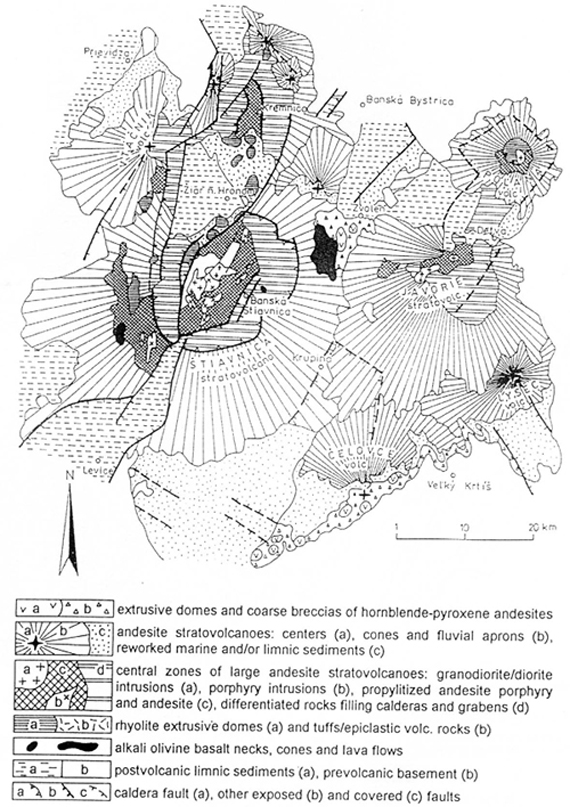 Figure
1. Volcanis structures around the Banska Stiavnica Caldera. Figure
1. Volcanis structures around the Banska Stiavnica Caldera.
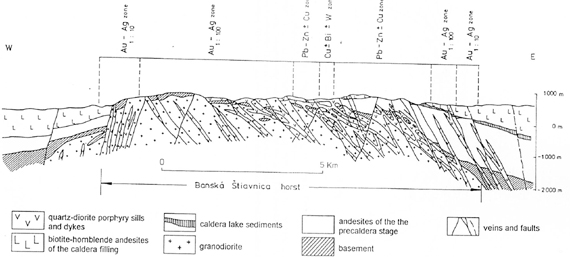 Figure
2.: Cross section across the Stiavnica strato volcano showing the distribution
of vein types. Figure
2.: Cross section across the Stiavnica strato volcano showing the distribution
of vein types.
The
ore district is situated in the central zone of the Stiavnica stratovolcano
(Fig. 1, Fig. 2), the biggest volcano of the Central Slovakia Neogene
Volcanic Field. This volcanic field, formed by products of areal andesite
volcanic activity with subordinate rhyolites, is situated at the inner
side of the Carpathian arc. Volcanic rocks are of the Badenian through
Pannonian age (16.5 - 8.5 Ma) and their petrogenesis is closely related
to subduction of flysch belt oceanic and/or suboceanic basement underneath
the advancing Carpathian arc and to back-arc extension processes (Lexa
et al. 1993). Volcanic rocks are similar to medium/high-K andesites
of continental margins or evolved island arcs involving older continental
crust. Petrography and geochemistry indicate mantle source magmas with
variable crustal contamination and differentiation in a shallow magma
chamber. The Stiavnica stratovolcano is the largest of the volcanoes
in this field, as well as the largest in the Carpatho-Pannonian area.
With its diameter almost 50 km it is a large volcano even in the world-wide
comparison. Unique in the Carpatho-Pannonian area there is also a large
caldera 20 km in diameter and a late stage resurgent horst in its center,
exposing basement and extensive subvolcanic intrusive complex. These
phenomena created conditions for extensive and long lived hydrothermal
systems, giving rise to one of the richest mining districts in Europe.
The extent of the ore district corresponds to the extent of the resurgent
horst.
Metallogeny
of the ore district The following types of ore deposits (mineralizations)
have been identified so far:
-barren quartz-pyrophyllite-pyrite system at Sobov
-magnetite skarn deposits and occurrences stockwork disseminated base
metal deposit
-porphyry/skarn copper deposits and occurrences
-intrusion related (?) gold mineralization
-hot spring type advanced argillic systems
-vein type epithermal base/precious metal mineralization
-metasomatic base metal mineralization
Vein type epithermal precious/base metal mineralization
Epithermal veins occupy the dominant position in multistage metallogeny
of the ore district. Generally, they might be regarded as an epithermal
gold-silver deposit despite the fact that, during the last fifty years,
base metals were the main objective of mining. The vein system is closely
related to post-caldera resurgent horst uplift (fig. 2) and covers almost
100 km . The complexities and depositional history the epithermal veins
are a result of interaction among the structural evolution of the resurgent
horst and evolving hydrothermal system with increasing meteoric water
component. The epithermal veins and their zonality correspond roughly
to the extent of granodionite/dionite bell-jar pluton. This may be an
argument to interpret the cooling pluton as a source of thermal energy
for the hydrothermal system. On the other hand, uplift of the resurgent
horst was accompanied by the emplacement of rhyolite intrusions and
extrusions along its marginal faults, indicating the presence of siliceous
magma in deeper levels. Siliceous magma responsible for the resurgent
horst uplift can be considered as an alternative and/or additional source
of heat and fluids for the post-caldera epithermal vein system.
Epitherrnal vein mineralization at the present surface level is distributed
in four zones (StohI in Bunian et al. 1985-fig. 6):
1. Cu-(Bi)
2. Pb-Zn-Cu
3. Ag-Au
4. Au-Ag-(Sb-Bi?).
Three vein types are distinguished:
1. base metal veins with increasing Cu-content in depth
2. silver sulphosalts veins with minor gold and base metals
3. gold veins with minor base metals in depth
According
to classification of Sillitoe (1993) low sulphidation epithermal veins
in the ore district belong to the sulphide and base metal poor and sulphide
and base metal rich types associated with calc-alkaline rocks.
A common zoning and succession of mineral stages on individual veins
favor a genetic continuum. Sulphide and base metal poor gold mineralization
represents the youngest event, often separated spatially from preceding
stages. Structural analysis indicate a change in stress field and activation
of a new set of faults. Mineralization occupies mostly marginal faults
of the resurgent horst, associating closely in space and time with emplacement
of rhyolites. Rhyolites occupy eventually an intermineralization position,
separating sulphide and base metal rich and poor epithermal systems
(Stohl et aI. 1967) or the first and second cycle in the sense of Kovalenker
et aI. (1991). A possible genetic link of sulphide and base metal poor
gold mineralization to siliceous magma has to be considered. Mineralogy
of veins is not known equally over the district. Marginal precious metal
veins are not accessible for recent studies, being abandoned long time
ago. MineralogicaI reconstruction of these veins is based on historical
mining records and rare samples in museum. Mineralogical description
of base metal and silver veins has been carried out by Kodčra (1956,
1959, 1960, 1963). In a recent study of the Michael ore shoot at the
Terézia vein (Kovalenker et aI. 1991) five mineralization stages have
been recognized:
I. Hematite-quartz including rhodonite, rhodochrosite)
II. Sphalenite (galena, chalcopynite, pynite, quartz)
III. Rhodonite, quartz, carbonates
IV. Galena-chalcopynite (sphalente, hematite, Bi-sulphosalts, scheelite)
V. Sulphosalts-baryte (quartz, iron-poor sphalenite, carbonates, chalcopynite,
pyrite, electrum, Ag-sulphosalts, acanthite, fluorite)
Kovalenker et al. (1991) have carried out also an extensive study of
physical-chemical aspects of mineral deposition. Fluid inclusions in
minerals of the second, fourth and fifth mineral stages indicate that
minerals precipitated from diluted Mg-Ca-Na chloride brines. Homogenization
temperatures of the second stage vary from 380 to 240 0C, salinity of
fluids varies between 0.5 and 11.5 wt% NaCI equiv. (TE = -30 to -39C),
a periodic fluid heterogenization (boiling) has been observed. Homogenization
temperatures of the fourth stage vary from 310 to 190 C, salinity of
fluids varies between 0.5 and 9 wt% NaCI equiv. (TE = -29 to -37 C),
in two sporadic inclusions increased Ca content is indicated by TE =
-43 to -48 0C, fluid heterogenization (boiling) has been observed. Homogenization
temperatures of the fifth stage vary from 225 to 125 C, salinity of
fluids varies between 0.5 and 11 wt% NaCI equiv., values above 7 wt%
NaCl equiv. being rare (TE = -27 to -37 C). Vertical extent of sampled
mineralization from the surface is 800 m. Restoration of the boiling
curve indicates its original depth as 800 - 1600 m during the second
stage and 400 - 1200 m during the fourth stage, indicating syngenetic
erosion and uplift.
Kovalenker et al. (1991) also modelled physical-chemical conditions
of ore deposition and came to the conclusion that the epithermal system
developed in two cycles divided by temperature and composition inversion
between the stages III and IV. The first cycle is connected with formation
of pollymetalic assemblages enriched in zinc, the second one with formation
of relatively lead-, copper-, bismuth- and antimony-rich ores including
assemblages of gold and silver minerals. Oxygen and hydrogen isotopes
studies indicate an increasing proportion of meteoric water in fluids
towards younger mineralization stages (Kovalenker et al. 1991, Kantor
et al. 1990).
The structure of individual veins is complex, branching and "en echelon"
patterns are frequent. Rich parts of mineralization are bounded to ore
shoots localized in bents and transtensioflal segments. Their vertical
extent is over 700 m. Striations indicate dip-slip movement with variable
strike-slip component. Preliminary results of structural analysis show
that while the pattern of sulphide and base metal rich veins corresponds
to the stress field with minimum stress axis oriented E-W to ESE-WNW,
the pattern of younger sulphide and base metal poor veins corresponds
to the stress field with minimum stress axis oriented NW-SE. The reactivation
of former veins was accompanied by a new set of veins around margins
of the resurgent hoist, and in the central part of the resurgent horst
in relation to a second order graben-like extension subsidence (Onacila
et al. 1993).
Most of the veins have banded texture, brecciation is frequent. Whilst
some of the breccias are tectonic, owing to continuous displacement
on veins during their evolution, most of the breccias have formed by
hydrothermal explosion mechanism indicating the state of boiling. No
related breccia pipes have been observed. Veins are hosted by massive
andesites, andesite porphyry, quartz-diorite porphyry, granodionte,
diorite and in the western part also, by basement rocks. Host rocks
are generally affected by propylitic alteration. Veins, especially the
sulphide and base metal poor ones, are accompanied by zones of silicification,
adularization and sericitization. Epidote, calcite and pyrite dominate
along sulphide and base metal rich veins in deeper levels. Alteration
minerals indicate a low sulphidation environment.
Most of the veins have banded texture, brecciation is frequent. Whilst
some of the breccias are tectonic, owing to continuous displacement
on veins during their evolution, most of the breccias have formed by
hydrothermal explosion mechanism indicating the state of boiling. No
related breccia pipes have been observed. Veins are hosted by massive
andesites, andesite porphyry, quartz-diorite porphyry, granodionte,
diorite and in the western part also, by basement rocks. Host rocks
are generally affected by propylitic alteration. Veins, especially the
sulphide and base metal poor ones, are accompanied by zones of silicification,
adularization and sericitization. Epidote, calcite and pyrite dominate
along sulphide and base metal rich veins in deeper levels. Alteration
minerals indicate a low sulphidation environment.
STOP-1
All Saints Adit, Hodrusa-Hámre
The vein
system represents an Ag-Au type base metal poor epihermal stockwork
network with some major veins. It situated at the eastern marginal part
of the caldera srtucture. The typical minerals are Ag-sulphoslats, acantite,
electrum, gold, rare sphalerite and pyrite. Alteration minerals are
quartz, carbonate, barite, fluorite.

Picture
1.: Geology cartoon of the All Saint stockwork Ag-Au deposit.
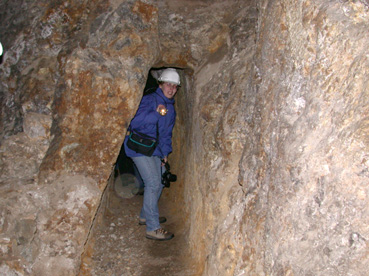
Picture
2.: Medieval adits were following the metal rich horisons of the veins.

Picture
3.: Strongly brecciated vein wall.

Picture
4.: Oxydized stockwork network exposed on the walls of the entrance
adit.
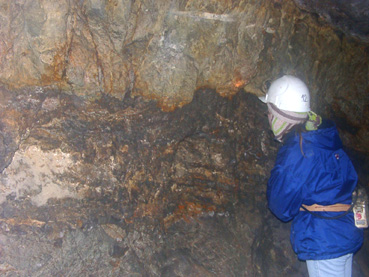
Picture
5.: One of the main veins, strongly oxydizied. The 1 metre thick vein
dips towards the observer.
STOP-2
Spitaler base and precious metal vein
The Spitaler
vein is one of the major NE-SW trending base melal-precious metal rich
vein system in the central Banska Stiavnica area. The vein belongs to
a group of veins that contain significant Pb-Zn-Cu in addition of precious
metals. The vein was mined from srface in the early times giving rise
a good open exposure of minerals. Banded, brecciated, colloform textures
appear in diferent speciment. Major ore mineral include sphalerite,
galena, chalcopyrite, Ag-sulphoslats.
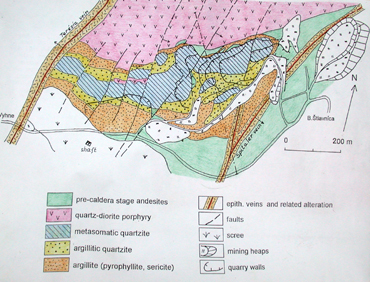
Picture
6.: Surface geology plan of Spitaler vein surroundings.

Picture 7.: Surface expopsure of the Spitaler vein. Note mined out mass
of the vein. The outcrop provides excellent specimens
of vein materials and wallrock alteration.
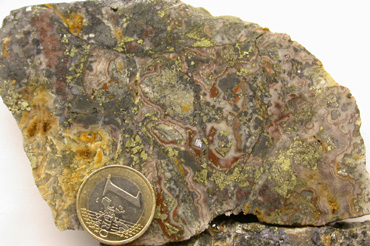
Picture
8.: Macro photograph of Spitaler vein sample. Note the brecciated and
collomorph stucture on the vein and also the ore minerals; chalcopyrite,
gelena, sphalerite.
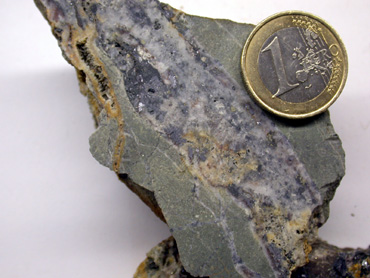
Picture
9.: Macro photograph of Spitaler vein sample. Quartz-galena vein in
propillitic andesite.
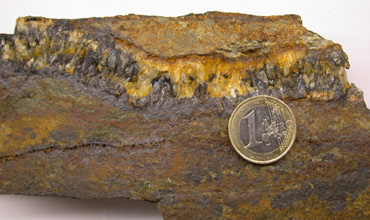
Picture
10.: Barren comb quartz vein with later filling of Mn-oxides.
STOP-3 Sobov quarry

Picture 11.: Geological section through the Sobov occurence.

Picture 12.: The quarry. Note large mass of pyrite rich rock both fresh
and oxydized.
The
high-sulphidation system at the locality Sobov north of Banská Stiavnica
is represented by an East-West oriented body of metasomatic quartzite,
which serves as a source of silica for refractory bricks (fig. 10).
1.3 m. tons of silica has been produced since the year 1951. The quartzite
body is 1000 m long and up to 200 m wide. Its central core consists
of pure massive quartzite with accessory rutile. Hydrothermal explosion
breccias have been observed in places. Pure quartzite passes outward
into the zone of gray, often vuggy quartzite with disseminated pyrite.
Metasomatic quartzites are surrounded by argillites, composed of pyrophyllite,
pyrite/marcasite and minor illite and diaspore. Hydrothermal explosion
breccias are present alsoJn this zone. Argillites are formed at the
expense of pyroxene andesites. Downward the hydrothermal system grades
into the east-west oriented zone of intense silicification, disseminated
base metal sulphides, minor Agsulphosalts and pervasive pyritization
in diorite intrusion, which is the most probable source of the hydrothermal
system. The hydrothermal system at Sobov affects pyroxene andesites
of the first stage of the volcano and its activity could continue until
caldera subsidence. Caldera lake sediments next to Sobov are altered
and/or silicified and include rare fragments of geysirite-Iike rocks.
However, quartzdiorite porphyry dykes and sills, as well as resurgent
hoist faults, postdate the system. Quartz-diorite porphyry contain rare
quartzite xenoliths, show a chilled intrusive contact with quartzite
and are not affected by silicification. Resurgent hoist faults and related
epithermal veins segment the quartzite body into a number of blocks
with relative displacement.
STOP-4
Kremnica Ag-Au veins

Picture
13.: The open area behind the group was caved-inn in the 17th sentury
during a major earthquake, because the hillside was weekend by the very
dense network of mining adits.
The
Kremnica Mts. are predominantly constituted by the Kremnica Graben of
N-S direction. On the western part, the graben is bordered by NE-SW
fault system and it is limited by the N-S striking Ihrács fault zone.
In the graben central part, an about 4 km wide tectonic block has been
upthrown. The Kremnica Graben began to have formed in Lower Sarmatian
only, in time of the activity of NW-SE and NE-SW tectonic strikes crossing
the area of the uplifted Kremnica block. This tectonic system was presumably
responsible for an extensive pyroxene andesite strato-volcanic formation.
By the end of the Badenian, the stratovolcano has undergone intense
denudation up to subvolcanic levels. The younger volcanic formations
are directly emplaced on the propylitized intrusions of the central
zone. After having been originated, the central part of the graben filling
was dissected by N-S and N NNE-SSW faults and uplifted as a local horst
in the Kremnica area. In later stages, tectonic lines were apparently
renewed and served as passageways for rhyolite dike and mineralization
solution ascending. By the end of Sarmatian and at the beginning of
Pannonian time, rhyolite volcanism took there place. In the Kremnica
horst, the hyohites are of dike nature being 10 to 100 m thick only.
They are considered to be of N-S orientation accompanying in dip and
strike the younger Au-Ag vein structures. After rhyolite origination,
the volcanic activity was of limited nature in the Krcrmnica Mts. In
the northern part, a small basaltoid andesite stratovolcano formed.
In the southern part, the some younger aphanitic basaltic andesite intrusions,
dikes, knobs and flows have been created.
Metallogenetic Evolution of the Kremnica Mts. Ore District
The evolution of melallogenesis in two individual mineralization stages
took there place being well distinguishable from temporal paint of view.
The Pb-Zn-Cu skarn mineralization stage is associated to subvolcanic
levels of the Upper Badenian andesite stratovolcano central zone referred
to the Zlatá Studina Formation.
The Kremnica Ore District veins are characterized predominantly by Au-Ag
mineralization, while the Sb and Hg one is of subordinate nature only.
Au-Ag -/ Pb-Zn-Cu ±Sb± /-Ag Vein type mineralization
This mineralization stage is associated with rhyolite volcanism of the
Jastrabá Formation (Upper Sarmatian-Pannonian) presumably including
polymetallic mineralization with increased Ag content. The subject mineralization
is younger than 11,7 m. y., which age the Stará Kremnicka rhyolite is
dated to. The Kremnica ore district veins are characterized predominantly
by Au-Ag mineralization while the Sb and hg on is of subordinate nature
only. The veins are related to the Badenian volcanic center and it has
tectonic connection to the pre-mineralization Kremnicka Horst. The Krenmnica
ore deposit is underlain by a hypothetic granitoid body being considered
as deep-seated equivalent of rhyolite extrusions and dikes which the
genesis of Au-Ag mineralization seems to be associated with. It is now
questionable, however, why just vein systems have been formed in the
central zone of this older volcanic edifice. There are two reasons to
be taken into consideration. Firstly, as constant thermal energy source,
the central zone was an optimum environment favourable for thermodynamic
hydrothermal regime generation. Secondly, the existing Kremnica Ore
Field is only a tectonically restricted part of the Au-Ag Vein System
in the frame of young post-rhyolite uparching of the Kiemnica Horst.
The limitation of this coincides with spatial distribution of the ore-localizing
structures. The vein zone and rhyolite dikes as well are considered
as tectonic elements constituting the horst.
The Kremnica Ore District mineralogy was subject to study in detail
by M. Böhmer (1965) having been completed by M. Korim (in Döhmer et
al., 1976). On the basis of studies mentioned, mineralization in two
evolution stages took there place:
1. Au-Ag Evolution Stage
2. Sb (Hg-As) Evolution Stage
An independent base metal rich ore formation period was also recognized
from the district. As proved by drilling survey the base metal mineralization
period is considerably widespread as northwards as in the depth. In
the 1st vein system an apparently increased silver content (50 to 120
g/t) and decreased Au content has been by noticed Knésl (1984). At the
same time, increased amounts in Pb, Zn and mainly in Cu were there observed.
The vein filling composition may be characterized as complex precious
metals-base metals.
The 1st Quartz Period is characterized by metasomatic replacement of
the wall rock quartz. In less amount, auriferous pyrite, arsenopyrite
and "cinopel" quartz are present. This period is considerably widespread.
The 2nd Quartz Period is filling the joints in the 1st one. It is represented
by pyrite, arsenopyrite and rare clusters of galena, sphalerite and
chalcopyrite. In the termination stage of this period, some higher electrum
concentrations have been noticed in the 2nd vein system (producing subperiod).
In addition to it, silver minerals (polybasite. pyrargyrite, argentite)
as well as tetrahedrite, bournonite and molybdenite were observed. In
the vein filling (gangue), adularia was found. In the 1st vein system
it is the Pyrite Introducing Period, which corresponds to the producing
sub-period mentioned.nm It is formed by quartz with a greater amount
of pyrite, less arsenopyrite. From among ore minerals, silver ones and
slightly dispersed electrum are there present. In addition to it, barite,
goethite and adularia have been observed as typical minerals.
The younger Sb (Hg, As) Evolution Siege begins with Quartz-Carbonate
Introducing Period being separated from the older evolution stage by
very intensive inter-mineralization tectonics of apparently dislocated
nature. The mineral association is relatively simple composed of antimonite,
pyrite and marcasite. From among gangue minerals, quartz and chalcedony
are observed. K-metasomatism is a typical vein and wall rock alteration
but other type of alteration such as sericitization, argillitization,
zeolitization, alunitization, silicification are also present.

Picture
14. Typical macro texture of sulphide barren vein fragments. Quartz
pseudomorphs after bladed calcite. Fine longer blades.

Picture
15. Typical macro texture of sulphide barren vein fragments. Quartz
pseudomorphs after balaed calcite. Thicker shorter blades.

Picture
16. Balded layers vary with thick banded quartz.
EPILOGUE

Participant
of the field trip: background; Gábor Kósa, Zsolt Benkó,
István Pári, Viktor Jáger, Zsolt Hefner, center line; Emese Gáspár,
Dóra Földeáki, Ágnes Nagy, Veronika Szilágyi, Rita Mohai, Anita Tóth,
Zsófia Wáczek, Péter Molnár, Dr. Ferenc Molnár, Dr. Peter Kodera,
foreground; Balázs Szinger, János Borsody, Krisztián Szentpéteri.
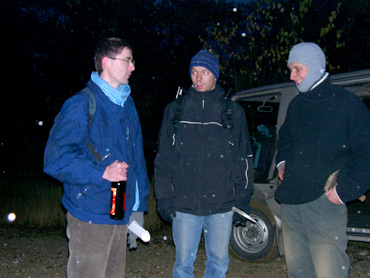
Dr. Peter
Kodera (Geological Survey of Slovak Republic, Bratislava), left, is
sincerely acknowledged for his excellent guidnece and supervision on
this Field trip by ELUSCSEG president, right.
Prof. Géza Hámor (Hungarian Institute of Geology) is also
acknowledeg for lending the van (background) for the time of our one
day field trip.
|
|

 Figure
1. Volcanis structures around the Banska Stiavnica Caldera.
Figure
1. Volcanis structures around the Banska Stiavnica Caldera. Figure
2.: Cross section across the Stiavnica strato volcano showing the distribution
of vein types.
Figure
2.: Cross section across the Stiavnica strato volcano showing the distribution
of vein types.
















